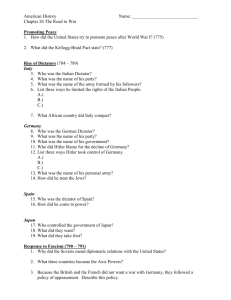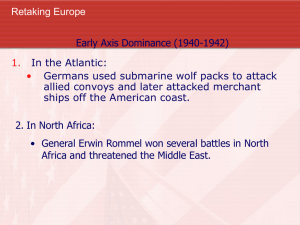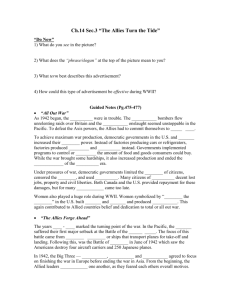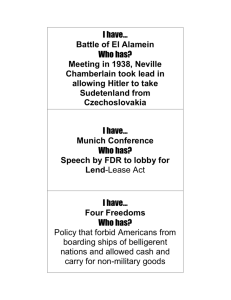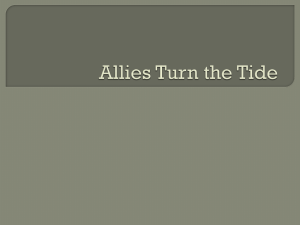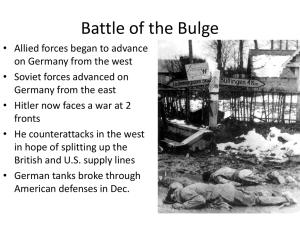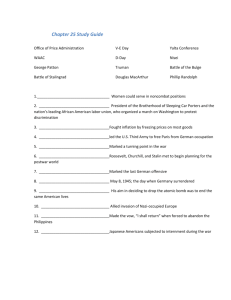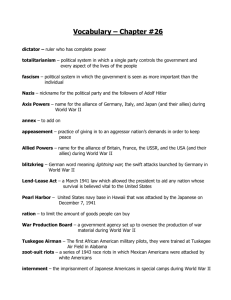Major Battles of World War II
advertisement
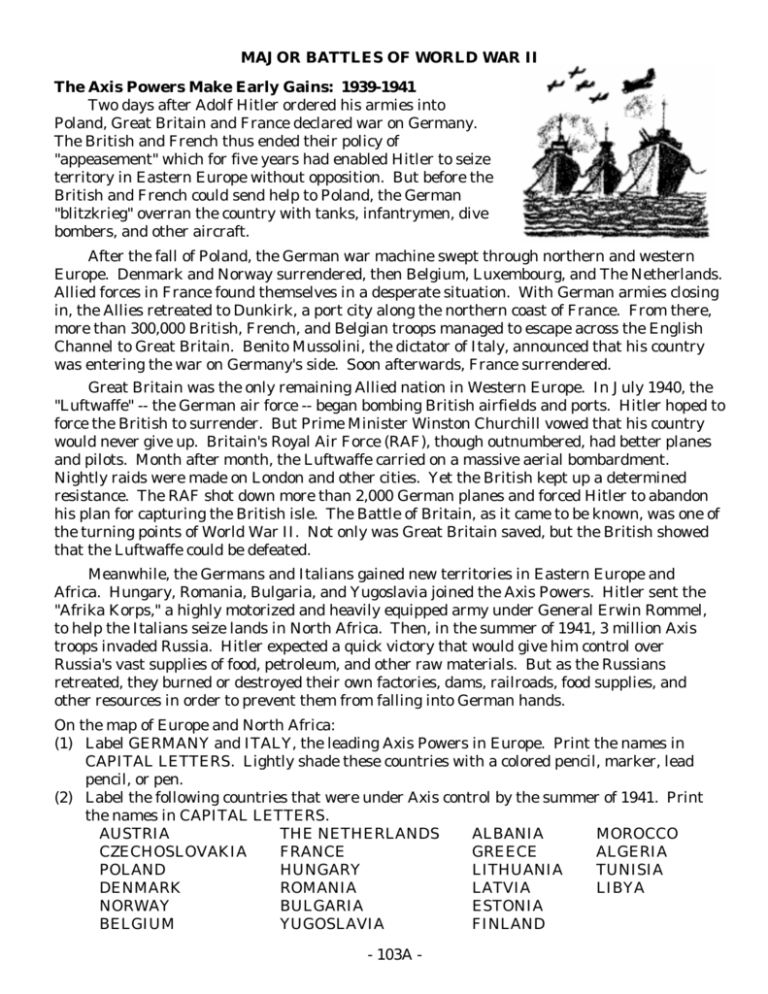
MAJOR BATTLES OF WORLD WAR II The Axis Powers Make Early Gains: 1939-1941 Two days after Adolf Hitler ordered his armies into Poland, Great Britain and France declared war on Germany. The British and French thus ended their policy of "appeasement" which for five years had enabled Hitler to seize territory in Eastern Europe without opposition. But before the British and French could send help to Poland, the German "blitzkrieg" overran the country with tanks, infantrymen, dive bombers, and other aircraft. After the fall of Poland, the German war machine swept through northern and western Europe. Denmark and Norway surrendered, then Belgium, Luxembourg, and The Netherlands. Allied forces in France found themselves in a desperate situation. With German armies closing in, the Allies retreated to Dunkirk, a port city along the northern coast of France. From there, more than 300,000 British, French, and Belgian troops managed to escape across the English Channel to Great Britain. Benito Mussolini, the dictator of Italy, announced that his country was entering the war on Germany's side. Soon afterwards, France surrendered. Great Britain was the only remaining Allied nation in Western Europe. In July 1940, the "Luftwaffe" -- the German air force -- began bombing British airfields and ports. Hitler hoped to force the British to surrender. But Prime Minister Winston Churchill vowed that his country would never give up. Britain's Royal Air Force (RAF), though outnumbered, had better planes and pilots. Month after month, the Luftwaffe carried on a massive aerial bombardment. Nightly raids were made on London and other cities. Yet the British kept up a determined resistance. The RAF shot down more than 2,000 German planes and forced Hitler to abandon his plan for capturing the British isle. The Battle of Britain, as it came to be known, was one of the turning points of World War II. Not only was Great Britain saved, but the British showed that the Luftwaffe could be defeated. Meanwhile, the Germans and Italians gained new territories in Eastern Europe and Africa. Hungary, Romania, Bulgaria, and Yugoslavia joined the Axis Powers. Hitler sent the "Afrika Korps," a highly motorized and heavily equipped army under General Erwin Rommel, to help the Italians seize lands in North Africa. Then, in the summer of 1941, 3 million Axis troops invaded Russia. Hitler expected a quick victory that would give him control over Russia's vast supplies of food, petroleum, and other raw materials. But as the Russians retreated, they burned or destroyed their own factories, dams, railroads, food supplies, and other resources in order to prevent them from falling into German hands. On the map of Europe and North Africa: (1) Label GERMANY and ITALY, the leading Axis Powers in Europe. Print the names in CAPITAL LETTERS. Lightly shade these countries with a colored pencil, marker, lead pencil, or pen. (2) Label the following countries that were under Axis control by the summer of 1941. Print the names in CAPITAL LETTERS. AUSTRIA THE NETHERLANDS ALBANIA MOROCCO CZECHOSLOVAKIA FRANCE GREECE ALGERIA POLAND HUNGARY LITHUANIA TUNISIA DENMARK ROMANIA LATVIA LIBYA NORWAY BULGARIA ESTONIA BELGIUM YUGOSLAVIA FINLAND - 103A - (3) (4) (5) (6) (7) (8) (9) Lightly shade these countries with the same colored pencil, marker, lead pencil, or pen that was used for Germany and Italy. Print Adolf Hitler inside of Germany, and Benito Mussolini next to Italy. Draw an arrow from Germany to Poland. Next to it, print 1939: World War II begins. Label the two major Allied Powers in Europe that the Germans failed to capture -- GREAT BRITAIN and RUSSIA. Label the countries that remained neutral: PORTUGAL SPAIN SWITZERLAND SWEDEN IRELAND Print the word neutral in parentheses below the name of each of these countries on the map. Fill in the boxes and battle symbols and trace the arrows in the map key with the same colors used to shade the Axis Powers and Allied Powers. Color the battle symbol next to London to represent an Allied victory. Next to it, print 1940-1941: RAF defeats Luftwaffe in Battle of Britain. Trace arrow 1 and arrow 2 to show Hitler's invasion of Russia. Between the arrows print 1941: Germany attacks Russia. _________________________________________________________________________________________ America Enters the War: 1941 When World War II began in 1939, the United States remained neutral. But German victories in Europe soon convinced President Franklin D. Roosevelt that the United States should start sending war materials to the Allies. He wanted America to become the "arsenal of democracy." Congress responded by passing the Lend-Lease Act in 1941. It provided the Allies, especially Great Britain and Russia, with more than $50 billion worth of arms, food, and other supplies. American and British ships helped transport these goods across the Atlantic Ocean to Europe. German submarines, or U-boats, constantly harassed Allied shipping lanes throughout the war. Eventually, the Allies were able to destroy more U-boats than the submarine could sink Allied ships. Some of the Lend-Lease aid went to China, which had come under attack by Japan in 1937. When the Japanese occupied Indochina in 1940, the United States stopped shipping gasoline, iron, steel, and other materials that might help Japan's armed forces. Relations between the United States and Japan grew steadily worse. On December 7, 1941, the Japanese suddenly struck the U.S. naval base at Pearl Harbor, Hawaii. The secret raid was carried out by a fleet of 33 ships and more than 300 warplanes. Within two hours, the U.S. lost 4 battleships, 3 cruisers, 3 destroyers, and 174 planes. More than 3,000 Americans were killed or wounded. The U.S. Pacific Fleet was dealt a crippling blow. President Roosevelt called December 7 "a date which will live in infamy." He asked Congress to declare war on Japan, and the declaration was quickly approved. Germany and Italy then declared war on the United States. Congress responded by declaring war on Germany and Italy. On the map of Europe and North Africa: (1) Next to arrow 3, print 1941-1945: U-boats attack Lend-Lease supply lines. On the map of the Pacific Region: (1) Label JAPAN in CAPITAL LETTERS. Show that Japan was an Axis Power by lightly shading it with the same colored pencil, marker, lead pencil, or pen used for Germany and Italy. (2) Next to the Hawaiian Islands, print Dec. 7, 1941: Japan attacks Pearl Harbor. - 103B - The Allies Defeat the Axis Powers in North Africa and Europe: 1941-1945 The tide of war turned in favor of the Allies late in 1941. German armies that had swept into Russia became bogged down in the mud, snow, and bitter cold of the winter season. They failed to capture Moscow and Stalingrad. A Russian counter-offensive forced them to retreat. American and British troops ended Axis resistance in North Africa during 1942 and 1943. Hitler had hoped to seize Egypt in order to control the Suez Canal and gain access to oil fields in the Middle East. But Rommel's Afrika Korps was caught between two Allied armies. A British force, commanded by General Bernard L. Montgomery, pushed the Germans and Italians westward from Egypt. A second Allied army, under General Dwight D. Eisenhower of the U.S., advanced eastward from Algeria and Morocco. The Allies won decisive battles at El Alamein in Egypt and in the country of Tunisia. After their victories in North Africa, the Allies crossed the Mediterranean Sea and attacked Italy. Political pressure in Italy led Fascist dictator Benito Mussolini to resign. The new Italian government surrendered, but the Germans continued to defend the country. The Allies fought their way up the peninsula and captured Naples, Rome, and Florence. Meanwhile, back in Great Britain, the Allies were ready to launch a great invasion across the English Channel to the northern coast of France. President Roosevelt and British Prime Minister Winston Churchill selected General Eisenhower as supreme commander of the Allied Expeditionary Force. The Allies had 3 million men, 16 million tons of weapons and supplies, 9,000 boats of various sizes, and 11,000 aircraft. Eisenhower's men landed on the Normandy coast of France on "D-Day," June 6, 1944. In the months that followed, the Allies drove through France, Belgium, and The Netherlands. The Germans launched a fierce counterattack, but were defeated in the Battle of the Bulge. Next, the Allies pushed forward into Germany itself. The Russian army by this time had fought its way through Poland and into Germany from the east. The Germans realized their position was hopeless, and surrendered on May 8, 1945. In the final days of the war in Europe, Italians who supported the Allies captured Mussolini and executed him. In Germany, Adolf Hitler committed suicide. On the map of Europe and North Africa: (1) Color the battle symbols at Moscow and Stalingrad to show the victories by Russia (an Allied Power) against the invading German army. (2) Color the battle symbol at El Alamein to show an Allied victory. (3) Trace arrow 4 and arrow 5 to show Allied campaigns in North Africa. Print Montgomery next to arrow 4, and Eisenhower next to arrow 5. (4) Color the two battle symbols in the country of Tunisia to show Allied victories there. Next to the symbols, print 1943: Allies defeat Rommel's Afrika Korps. (5) Trace arrow 6 from Tunisia across the Mediterranean Sea to Italy. Color the battle symbols to show Allied victories at Naples, Rome, and Florence. Next to arrow 6, print 1944: Italy surrenders. (6) Trace arrow 7 to show the Allied invasion of northern France and final drive into Germany. In northern France, print June 6, 1944: D-Day. Print Eisenhower next to the arrow. Color the battle symbol to show an Allied victory in the Battle of the Bulge. (7) Trace arrow 8 from Russia through Poland to Germany. Next to it, print Russian Army. (8) Where arrows 7 and 8 meet, print May 8, 1945: Germany surrenders. _________________________________________________________________________________________ The U.S. Defeats Japan in the Pacific Region: 1942-1945 In the months following the attack on Pearl Harbor, the Japanese added new lands to their -103C - empire. By the spring of 1942, Japan controlled a vast area that included Korea, Burma, Thailand, Indochina, Malaya, the Dutch East Indies, the Philippine Islands, part of China, and hundreds of islands stretching from Alaska to Australia. The United States was finally able to halt Japan's string of victories by winning two crucial battles in May and June of 1942. The Battle of the Coral Sea, in which planes based on aircraft carriers did all of the fighting, prevented a Japanese invasion of Australia. The Battle of Midway removed the threat of another attack on Hawaii. These American victories proved to be the turning point of the war in the Pacific. The United States then adopted an "island-hopping" strategy for pushing the enemy back toward Japan. The idea was to capture certain key islands, one after another, until Japan came within range of American bombers. The plan eventually succeeded, but only after a long and difficult struggle. Japanese soldiers believed in fighting to the death. During the last year of the war, the enemy started using "kamikazes," or suicide planes. Pilots would deliberately crash their bomb-laden planes into American warships. Gradually, however, U.S. forces achieved their objective. Important victories were won at the battles of Guadalcanal (1942); Tarawa (1943); Kwajalein, Saipan, Guam, and Leyte Gulf (1944); and Iwo Jima and Okinawa (1945). The Battle of Leyte Gulf was the largest air-sea engagement in history. American forces destroyed much of the Japanese main fleet. General Douglas MacArthur, the Supreme Allied Commander in the Southwest Pacific, was then able to recapture the Philippines. Two-and-ahalf years earlier, MacArthur had been driven from the islands by the Japanese. At that time, he made the pledge "I shall return." He kept his promise. The conquest of the Philippines, and the subsequent victories at Iwo Jima and Okinawa, brought U.S. forces within a few hundred miles of the Japanese mainland. President Roosevelt died in April 1945, soon after beginning his fourth term. He was succeeded by Vice-President Harry S. Truman. Truman directed the final assault on Japan. Hundreds of American bombers made daily strikes against Tokyo and other major cities. Plans were drawn up to invade the Japanese islands. But before an invasion could begin, Allied scientists informed President Truman that they had developed a powerful atomic bomb. The Allies asked the Japanese to surrender and accept a fair peace settlement. When they refused, two atomic bombs were dropped on the cities of Hiroshima and Nagasaki. More than 100,000 persons were killed. The government of Japan then decided to give up the fight. World War II came to an end on September 2, 1945. On the map of the Pacific Region: (1) Trace the dotted line that shows the extent of the territory held by Japan at the height of its conquests. Next to the line, print Japanese Empire, 1942. (2) Color the battle symbols at Midway and Coral Sea to represent Allied victories. Next to each, print Turning point of the war, 1942. (3) Trace arrow 9 and arrow 10 to show the Allied "island-hopping" campaign in the southwest Pacific. Color the battle symbols to represent Allied victories. Next to each symbol, put the year when the battle took place. (4) Next to Leyte Gulf, print Gen. Douglas MacArthur returns to the Philippines. (5) Next to Hiroshima and Nagasaki, print U.S. drops atomic bombs on Japan; World War II ends on September 2, 1945. - 103D - - 103E - - 103F -
